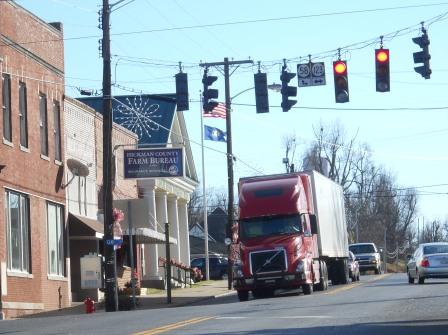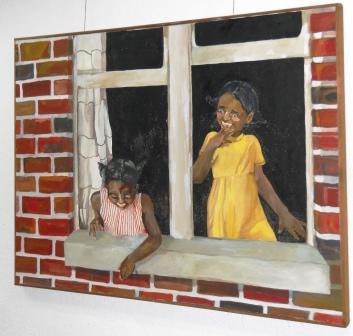Jack L. Calbert
Wednesday, December 5, 2012 2:26 pm
US 51 was a concrete slab road, an accomplishment of Herbert Hoover and Franklin Delano Roosevelt, part of the New Deal federal network of two-lane roads. It appeared in Hickman County during the early 1930s, and today Americans still use and depend upon it and other New Deal roads for rural transportation.

By the mid-1950s, Highway 51, like much of the New Deal network, was drowning in bumper-to-bumper auto/truck traffic; there was no Interstate system. The road connected Chicago with the lower South. This meant heavy north-south traffic through Clinton’s court square, much of it black people traveling back and forth between Chicago and friends and relatives in Mississippi.
Not only was this traffic dangerous in terms of an overloaded narrow two-lane highway; it involved social and cultural complications for big-city blacks passing through small insular southern towns. Clinton was the first sizable lawfully racially segregated services’ town on the highway below the Ohio River. To further complicate things Kentucky’s Jim Crow laws were in the process of being declared unconstitutional by the US Supreme Court and were moving toward collapse.
In heavy traffic motorists are always looking for a place to stop, have a meal, and unwind. Many were halted by the stoplight at Clay Street, where a helpful gathering of white males counseled them to “keep movin” to Fulton where they could enjoy a beer and a meal. Most kept moving. Fulton restaurants served a large Illinois Central passenger crowd and offered alcohol with food.
Those stopping in Clinton were met with something worse than Hickman County’s dry law. The Jim Crow laws took effect at the Ohio River, 30 miles up 51 from Clinton at Cairo, Illinois. Here the Illinois Central Railroad segregated its passenger cars, and a complex mess started up.
During the ‘50s this railway traffic was shifting from trains to private motor vehicles, and I was a teen-age white male clerk/soda attendant at Henry Featherstone’s Clinton Drugs, located a few feet off the busy 51 right-of-way. We had a big Rexall sign outside the front door which encouraged motorists to stop, patronize the soda fountain, and luxuriate in air-conditioning. During the ‘50s AC was usually found only in movie houses and drug stores.
Inside Clinton Drugs there were Jim Crow rules well-known in Clinton, but not to outsiders. There were no posted signs spelling out the rules as existed in Illinois Central depots. Nevertheless the soda fountain which sat in the middle of the store was reserved for whites only. The pharmacy at the rear of the store was open to both races (as were the retail counters), but everybody had to pass through the fountain area in order to reach the pharmacy. Black money was good at the pharmacy cash register, not at the fountain one.
I was a teen-ager and thought nothing of all this. Preachers and teachers never criticized the system (they knew not to; I recall Maria Porter Brinkley obliquely criticizing racial bigotry, but one had to be alert to take her point; Cecil Page at First Methodist Church once or twice criticized “racial churches” in Sunday evening sermons attended by a small select group of parishioners). I thought what went on at Clinton Drugs perfectly normal.
Henry Featherstone was a traditional white racial segregationist and pharmacist who rigorously enforced Kentucky law. Even he, however, sometimes mumbled, “It’s coming,” meaning the days of Jim Crow were numbered. Enforcing such laws in an increasingly mobile society was completely impractical; these laws were designed for rural society where everybody knew everybody and their “place.” Outsiders were few in these rural locales.
Henry had a thriving pharmacy and soda fountain trade; he was likable and entertaining. A World War II veteran he had a deep interest in that conflict, and I learned considerable World War II history from him. He had an “ugly handsome” appearance, once summed up by a dissatisfied customer who told him he must have been “hit in the face with a biscuit.” I snickered at that which displeased Henry. Eventually he hit me in the face with something bigger than a biscuit.
My come-uppance came on a Saturday when a traveling black man of sophisticated demeanor walked into the store, approached the fountain, and asked for two cups of coffee. The store was full of local fountain customers, so I drew the man aside and explained he could only have take-out coffees, because we did not serve blacks at the fountain. He said he knew where he was, and he would take the take-outs. I prepared them, and then he wanted sugar and cream in the coffees. I brought them, and in the process of stirring he sat down on a counter stool.
Henry turned purple; his face was a terror to behold when angry.
At the time I was reading Victor Hugo’s Les Miserables (checked out of the Clinton public library), and Hugo’s famous sentence came floating through the air: “ What is the face but a reflection of the soul?”)
When the man left Henry ordered me never again to allow “one” to sit at the fountain. I knew then we were all into something bigger than an attempt to enforce an outdated and unfair law.
When a year or so later I moved to Nashville and Vanderbilt, I again found myself among comfortable white people wanting no changes. They all turned out to be on the wrong side of American history.
